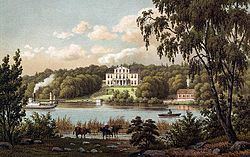 | ||
Lp heroine s quest exploring fornsigtuna 2
Fornsigtuna (forn means ancient), Old Sigtuna, Sithun, Sign(h)ildsberg or Signesberg (59°37′N 17°39′E) is located in the parish of Håtuna approximately 4 kilometres (2.5 mi) west of the modern town of Sigtuna, by lake Mälaren, in Sweden. Although the location is nearly forgotten, it has a central role in Norse mythology.
Contents
- Lp heroine s quest exploring fornsigtuna 2
- Heroine s quest fornsigtuna
- Heimskringla
- Skaldic poetry
- Gesta Danorum
- Archaeology
- History
- References
Heroine s quest fornsigtuna
Heimskringla
In Chapter 5 of the Ynglinga saga section of his Heimskringla, Snorri Sturluson relates that Odin and the Æsir first arrived at Old Sigtuna when they came to Sweden:
Odin took up his residence at the Maelare lake, at the place now called Old Sigtun. There he erected a large temple, where there were sacrifices according to the customs of the Asaland people. He appropriated to himself the whole of that district, and called it Sigtun. To the temple priests he gave also domains. Njord dwelt in Noatun, Freyr in Upsala, Heimdal in the Himinbergs, Thor in Thrudvang, Balder in Breidablik; to all of them he gave good estates.Later the pirate Sölve arrived at Old Sigtuna to claim the Swedish throne:
Solve came unexpectedly in the night on Eystein (Östen), surrounded the house in which the king was, and burned him and all his court. Then Solve went to Sigtun, and desired that the Swedes should receive him, and give him the title of king; but they collected an army, and tried to defend the country against him, on which there was a great battle, that lasted, according to report, eleven days. There King Solve was victorious, and was afterwards king of the Swedish dominions for a long time, until at last the Swedes betrayed him, and he was killed.In the part called The Saga of St. Olaf, the Norwegian king Olaf Haraldsson makes shore at Old Sigtuna:
King Olaf steered thereafter eastwards to Svithjod, and into the Lag (the Mælar lake), and ravaged the land on both sides. He sailed all the way up to Sigtuna, and laid his ships close to the old Sigtuna. The Swedes say the stone-heaps are still to be seen which Olaf had laid under the ends of the gangways from the shore to the ships.Skaldic poetry
In Orvar-Odd's saga, Hjalmar laments his dying:
The location is also mentioned in other poems by the 11th-century skalds Þjóðólfr Arnórsson Valgarðr á Velli and Arnórr Þórðarson.
Gesta Danorum
Saxo Grammaticus writes in Book 8 of Gesta Danorum that Sigmund, one of the warriors of the House of Yngling, came from what is chronologically Old Sigtuna to fight at the Battle of Bråvalla:
They likewise held the god Frey to be the founder of their race. Amongst these from the town of Sigtun also came Sigmund, a champion advocate, versed in making contracts of sale and purchase; besides him Frosti surnamed Bowl: allied with him was Alf the Lofty (Proud?) from the district of Upsala; this man was a swift spear-thrower, and used to go in the front of the battle.Archaeology
There are two large ruins that had been two large three-aisled halls, a series of terraces just above the shore-line of the Germanic Iron Age, traces of a harbour, a large mound and a number of smaller grave fields. Excavations have dated the remains to the Vendel Age, part of the Germanic Iron Age, and the Viking age, i.e., from the 6th century until the 11th century.
History
It was an Iron Age and mediaeval royal estate (see Uppsala öd) and it was located strategically at the waterway to Old Uppsala and the Temple at Uppsala. In the 10th century, the name was transferred to modern Sigtuna, which apparently assumed many of its functions.
Since the 17th century, the location has been a manor named Signhildsberg or Signesberg.
